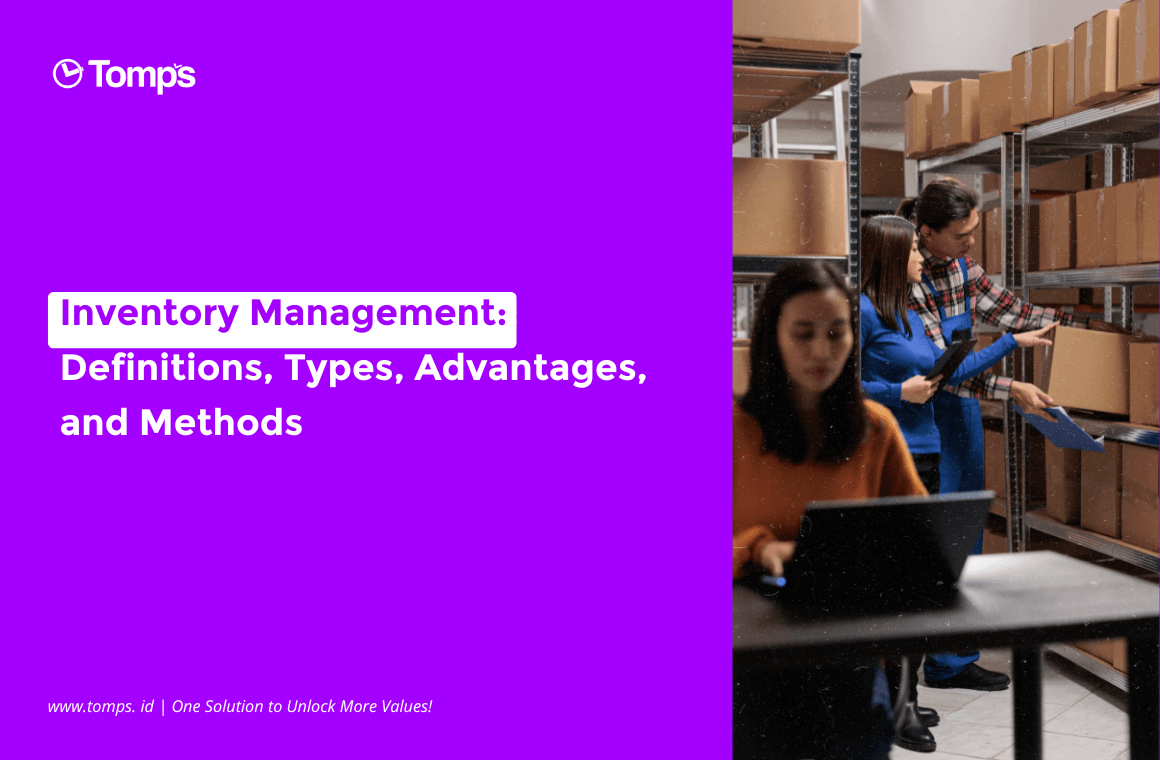To manage a company, a leader cannot walk alone without the support of the management. To be able to carry out their role optimally, leaders need support from financial management to manage company finances, and human resource management to manage people who work in the company and other divisions so that work runs more effectively and efficiently. To understand the importance of management in a company, here is a review that Tom-Mates needs to understand!
DEFINITION OF MANAGEMENT
According to Siswanto (2012:1), management is the art and science of planning, organizing, motivating, and controlling other people and working mechanisms to achieve goals. Meanwhile, according to Terry in Nawawi (2011:11) management is the achievement of organizational or company goals that have been determined using the hands of others. According to the Big Indonesian Dictionary (KBBI), management is the effective use of resources to achieve goals. From these various opinions, it can be concluded that management is everything that is done to measure and manage various sources to achieve goals effectively and efficiently.
MANAGEMENT OBJECTIVES
According to Siswanto (2012: 28), it is something to be realized that describes a certain scope and suggests a direction to a manager. In general, management objectives can be explained as follows:
- To determine the most effective and efficient strategy to pursue the goals set by the organization
- Regulate mental health, economy, and all company factors so that the company can achieve maximum profit
- Evaluate and review the situation to make adjustments to existing strategies
- Evaluate and review the strengths, weaknesses, opportunities, and threats that exist to the company
MANAGEMENT FUNCTION
According to Terry in Nawawi (2011:11), there are 4 management functions, namely:
1. Planning
Is a process to define organizational goals, create strategies to achieve goals, and develop plans for organizational work activities. From a management perspective, the planning stages have several levels. Here are some levels that are generally carried out in many companies:
- Top-level planning
Usually carried out at the managerial level, directors, to company leaders. Therefore, many call this level strategic. Here, managers and directors develop several general guidelines, formulate company goals, find the best way to make decisions, and work out the best ways to solve problems.
- Middle-level planning
It is usually the responsibility of a section head, division head, or equivalent. This level of planning is usually administrative such as outlining how the company’s goals or general guidelines that have been formulated at the top managerial level will be carried out later.
- Low-level planning
This planning level has involved all levels of staff and employees. Each company employee must have a plan to carry out their respective duties so that the company’s stated goals can be achieved later.
2. Organizing
Is the process of collecting the necessary activities, namely determining the organizational structure as well as the duties and functions of each unit in the organization. In addition, it also determines the position and nature of the relationship between each unit.
3. Briefing
That is an effort to move members of the organization so that they are willing and trying to achieve the company’s goals and objectives to the fullest
4. Control
Is the process of determining what will be achieved, measuring, and correcting implementation activities. The supervisory function of a company can run well and effectively if it fulfills the following aspects:
- Routing
Often an employee makes a mistake in doing his job. To minimize this problem from happening again, a manager must determine the way or path of work to find out at which point the problem generally occurs. In the end, the problem can be avoided.
- Scheduling
A manager must determine when supervision should be carried out. This scheduling can be done once a week, once a month, or up to once a year. However, some managers do sudden scheduling to find problems or problems that are often not found in monthly or weekly inspections.
- Dispatching
After finding the points where improvements must be made, the next step is for the manager to delegate to the relevant parties to make improvements. Not only that, but the manager must also provide the best solutions on how to overcome these problems.
- Follow up
The last control process is to do a follow-up. Monitor the parties who have been delegated the task to carry out the above improvements. Have they managed to overcome the problems? Or is there a new problem? Do follow-up until the problem is resolved.
ELEMENTS OF MANAGEMENT
According to Hasibuan (2013:2) management consists of 6 elements, namely:
1. Man
Humans are the most decisive factor in the sustainability of management. The role of humans is to make goals and humans also carry out the process of these goals. Without humans, there is no process to achieve this goal.
2. Money
Money is a medium of exchange and a measure of value. The size of the results of activities can be measured by the amount of money circulating in the company. Therefore money is important to achieve goals and is calculated rationally. This relates to how much money must be provided to finance workers’ salaries, and the tools needed to achieve organizational goals.
3. Materials
Consists of semi-finished and finished materials. To achieve better results, besides requiring humans who are experts in their fields, they must also use the best materials for maximum results. Of course, it must also adjust to the company’s finances to provide the necessary materials.
4. Machine
Machines are one of the supporting facilities in company activities so that work runs more effectively and efficiently
5. Method
If a job is done with a good method, it will have an impact on the smoothness of the work. Choosing which method is suitable is not easy, including when you will use a project management application to make work easier. One project management application that you can use is Tomps. With Tomps, you can control the project even if you are not on-site in real-time and transparently which will certainly make the project work easier.
6. Market
If the goods have been produced, of course, the goods must be marketed to the right market so that the goods are sold. Therefore, market control in the sense of spreading the production is a determining factor in the company.
TYPES OF MANAGEMENT
Quoting from Binus University site, there are various types of management as follows:
1. Strategic
In practice, strategic management has an executive function that will plan, analyze, and implement the right strategy to maintain the company’s competitive advantage. Activities carried out in the field of strategic management include the following:
- Establish company goals that become the initial basis for operational activities.
- Develop policies by the goals that have been set.
- Plan and allocate the required resources.
- Realize all policies by the desired target.
2. Sales
In this case, it is the sales management that not only implements a buying and selling policy but also ensures that the company can still make a profit.
3. Marketing
The field of marketing management is not only about marketing products and services. In practice, they are also expected to be able to make marketing strategies, plan products, define brands, and determine target markets. Activities carried out in the field of marketing management include the following:
- Conduct market research by researching and identifying consumer desires.
- Perform marketing planning by determining market segmentation and the method used.
- Carry out market analysis to find out the challenges and constraints faced.
- Promoting products can be done with advertisements, banners, billboards, brochures, and so on.
- Manage marketing efforts to increase product demand.
4. Public Relations
The main task of this division is to ensure that a company has good relations with local communities, public organizations, or governments.
5. Operation management
The scope of work in this field is quite broad and mostly relates to how a company works operationally. Operations is also related to retail and manufacturing. Activities carried out in the field of operations include the following:
- Doing planning in the company’s operational activities.
- Set the scale of the company’s applied inventory.
- Determine the level of work processes in the company.
- Control the quality of raw materials and resources used.
- Maintain and maintain the performance of the tools and machines used.
6. Human Resource
In this case, he is fully responsible for the management of human resources, including in terms of recruiting, training, compensating, rewarding, and ensuring that every employee has a good performance.
7. Technology and Information
This management is not only related to the world of information technology but also its management. The management in question is data management which consists of the process of searching, compiling, classifying, and showing all data related to the company’s activities and becomes the basis for making decisions.
8. Financial
In charge of managing every process carried out by the finance team of a company. This management will also ensure that the company can benefit from every effort it put in.
9. Supply Chain
Its main tasks are similar to sales management. The difference is, that this management focuses more on the process while sales management focuses on the result.
10. Project
This management is concerned with planning, organization, control, and all efforts involved in the project management process in a company.
11. Risk
The main task of this management is to ensure that every risk has been managed properly so that later it can be avoided or utilized for the benefit of the company.
12. Quality
In charge of managing and ensuring all efforts are made to improve the quality of a company’s products or services.
13. R&D
This management strives for research and development carried out by the company. The management is also not far from policies regarding this matter and how every effort made is truly by the company’s vision and mission.
14. Program
The main task of this division is to ensure that the project portfolio management takes place according to the company’s vision and mission.
15. Facility
Related to the management of every infrastructure in the company and ensuring that all of them can provide benefits to the company.







